This is hands-down the best fermented sauerkraut recipe I’ve tried at home! It’s also perfect for beginners, so whether you are a seasoned fermenter or have never fermented before, you can make this incredible sauerkraut!
Homemade sauerkraut is easier than you might think! Our simple recipe guides you through the process, and while it takes about a week for fermentation, the hands-on prep is minimal.
Trust me, the wait for fermented sauerkraut is worth it. Thanks to lacto-fermentation, the flavor after a week is incredible, and your homemade sauerkraut will keep in the fridge for months. If you need sauerkraut now, check out our quick sauerkraut recipe, which is ready in about an hour!
Key Ingredients and Equipment
- Cabbage: I use a large green cabbage for traditional sauerkraut. Green cabbage has a mild flavor, firm texture, and enough natural sugars to help the ferment. (For homemade kimchi, I use Napa cabbage instead.)
- Salt: Use kosher salt or sea salt. I like Redmond Real Salt, but pickling salt, Celtic salt, Himalayan pink salt, Morton’s, or Diamond Crystal will all work. Don’t use iodized salt, which can interfere with fermentation.
- Spices: This is a classic German sauerkraut recipe, so I stick with allspice berries, juniper berries, peppercorns, and caraway seeds.
- Sugar: A teaspoon of sugar helps kickstart the fermentation.
- Mason Jar: For this recipe, I use half-gallon jars, and the amount of brine (salty water) is designed for that size. If needed, you can use two 1-quart jars, but you must adjust the brine amount (see the recipe below).
- Glass Fermentation Weights: Weights help submerge the cabbage in the brine, which is critical for successful fermentation. I like glass weights because they’re easy to clean.
- Fermentation Lids with an Airlock (optional): An airlock makes fermenting super easy because it lets gases escape from the jar. Without one, you’ll need to open the lid daily to release the gas buildup. (Check out the photo below to see what an airlock looks like!)
How to Make Fermented Sauerkraut
Now, let me show you how easy this recipe is to make. First, you’ll need to prep your cabbage. I start by removing the core and then thinly slicing the cabbage. Once that’s done, toss the cabbage with salt and spices. This helps draw out moisture and start the breakdown process. Cover the bowl with a dish towel and let it sit for 30 minutes.
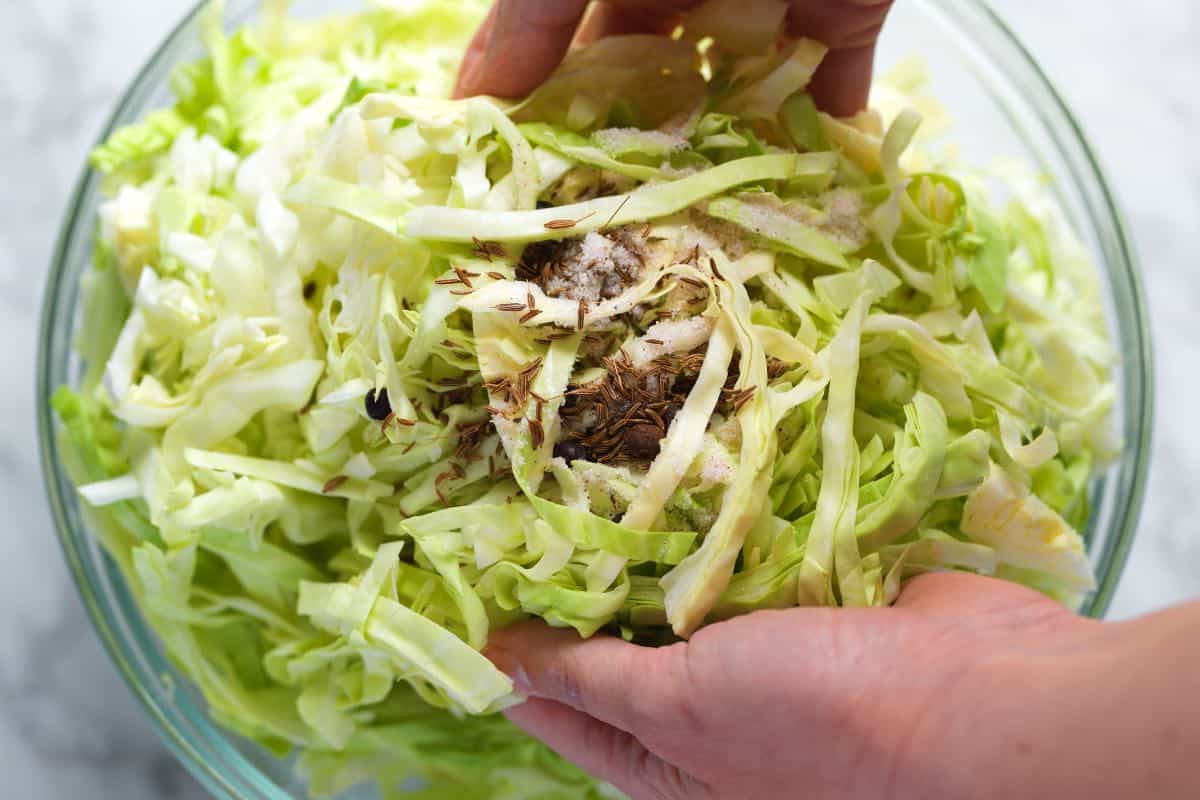
After 30 minutes, it’s time to get hands-on! Use clean hands to crush the cabbage and salt mixture for about two minutes. You’ll be amazed at how much it wilts and shrinks. Now, let the cabbage rest for another 30 minutes.
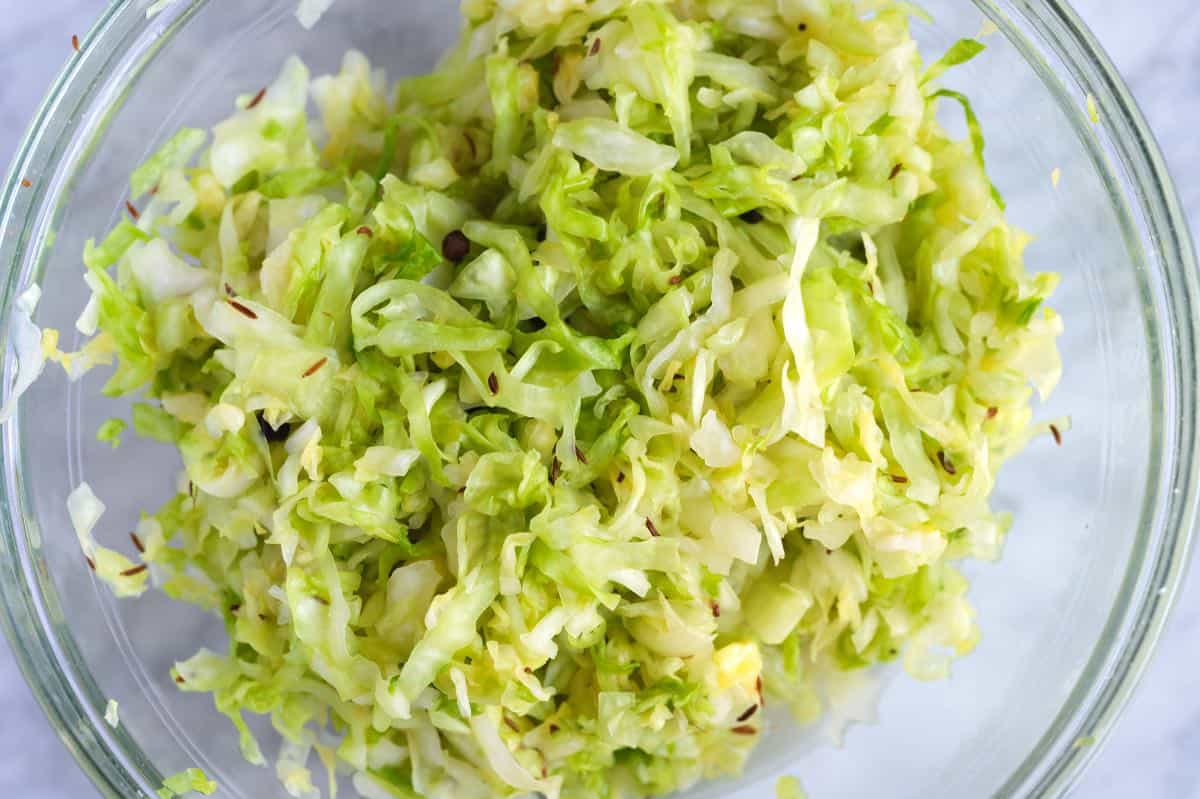

Next, add a teaspoon of sugar, give it another good mix, and pack it tightly into your sanitized jar. If you have a fermentation weight, now’s the time to place it on top. The final step is to pour enough salt brine (a 2% water and salt solution) to cover the cabbage completely.
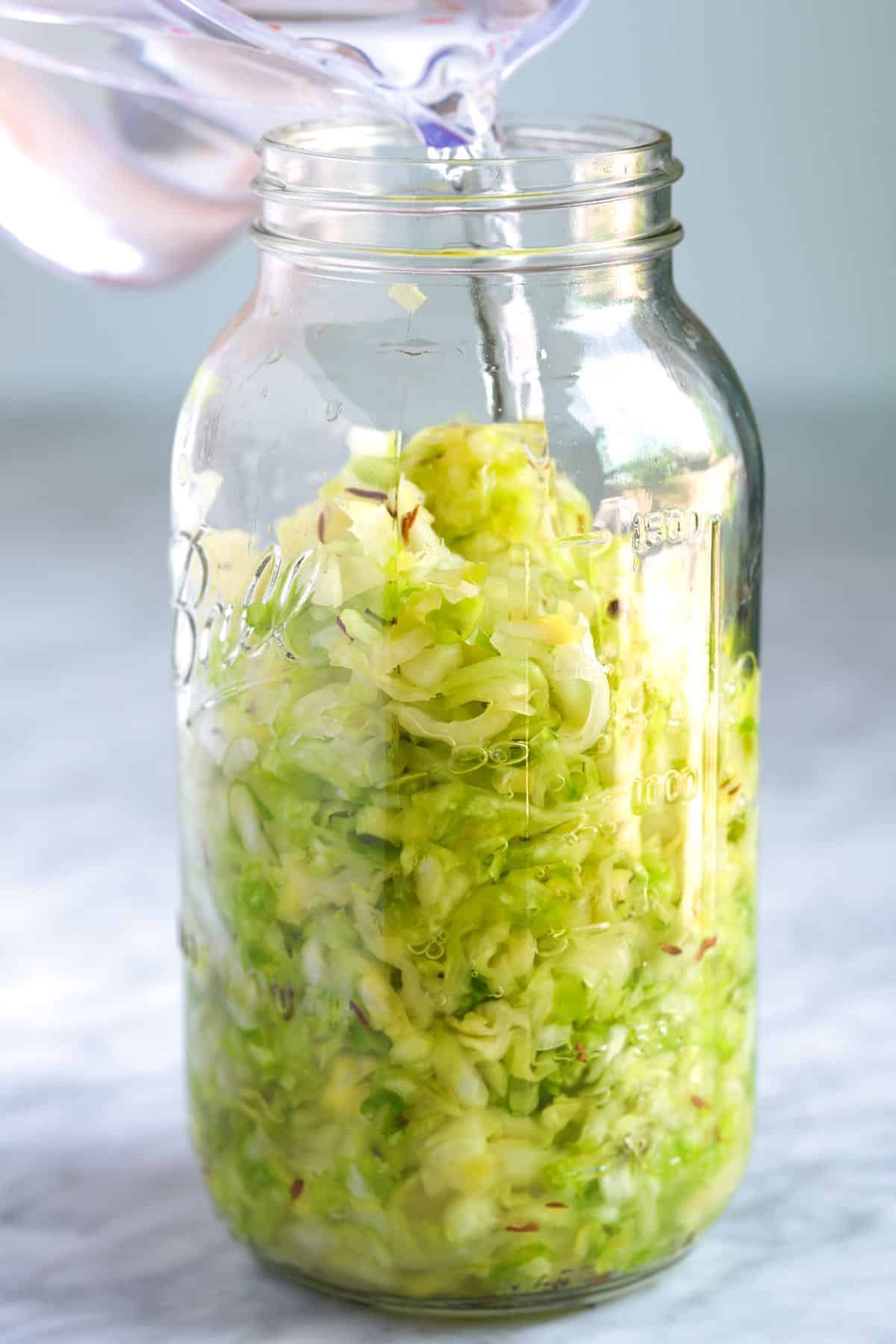

Seal the jar with its lid, or use a fermentation lid with an airlock (recommended). The airlock makes fermenting super easy because it releases gases produced during the process. If you don’t have an airlock, you must open the jar daily to let those gases escape.
I like to place my jar inside a bowl on the counter. This way, if any liquid seeps out during fermentation (it doesn’t always happen, but it’s good to be prepared), the bowl will catch it.
Now, let the sauerkraut ferment for 1 week. You might see some bubbles forming – that’s a good sign! After a week, replace the airlock with a regular lid, transfer the jar to the fridge, and enjoy your homemade sauerkraut with your favorite dishes.
Check out the photo below to see what my sauerkraut looked like after a few days of fermenting. Those bubbles mean the fermentation is working its magic!
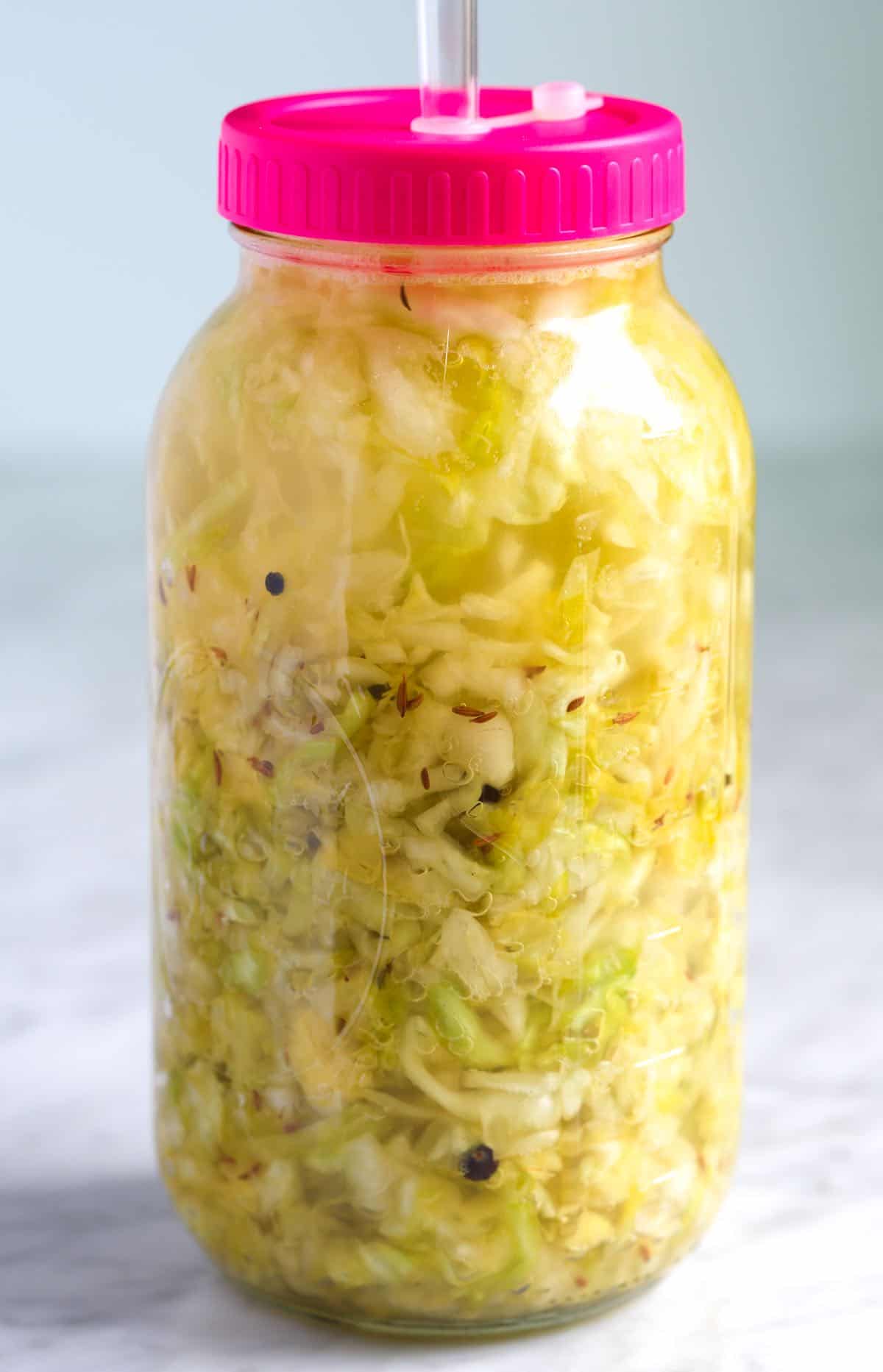

What to Eat with Sauerkraut
I love sauerkraut and could happily eat it on its own. But it truly shines when paired with other dishes, especially pork (hello pork recipes!). Pork and sauerkraut are a classic combination, so next time you’re making pork chops, pork tenderloin, or even Swedish meatballs, consider serving them with a side of sauerkraut, either cold from the fridge or warmed up. It’s also fantastic with bratwurst and other sausages.
If you’re looking for something lighter, try adding a spoonful of sauerkraut to your favorite salads or grain bowls or mixing it into creamy potato salad for a tangy twist. You can even incorporate sauerkraut into soups like a classic sauerkraut soup or add it to cabbage and ham soup for an extra pop of flavor.
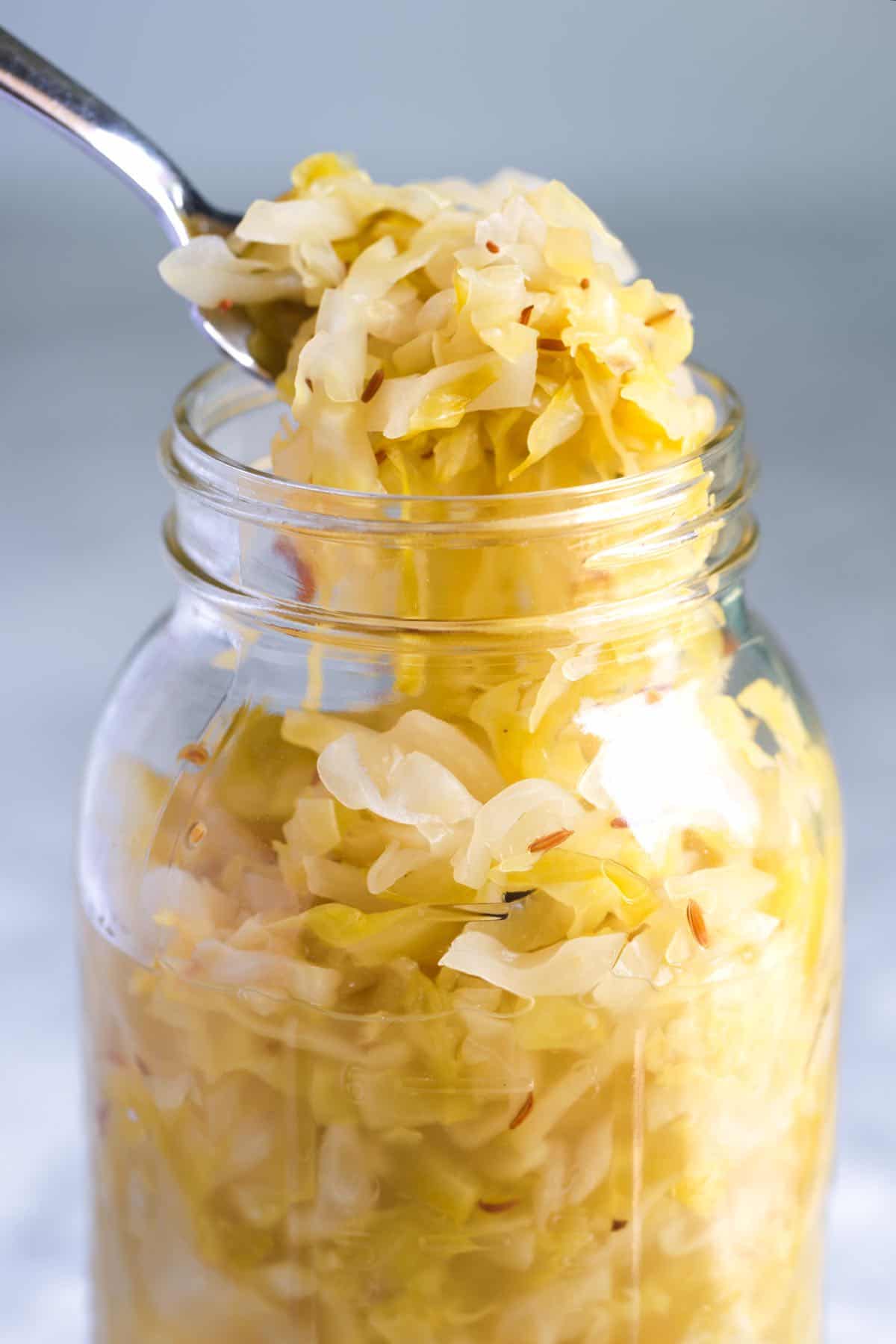

Fermented Sauerkraut (Beginner Friendly!)
This homemade sauerkraut recipe is perfect for beginners and tastes delicious, with traditional German spices like juniper and caraway. We have provided ingredient amounts by weight for safety and the best results. Use a kitchen scale to weigh your ingredients for this fermented sauerkraut recipe.
Equipment: We recommend using one sanitized half-gallon jar with an airlock and glass weight (see article). If you do not have an airlock, you must vent the gas daily during fermentation, which requires you to open the top to release gas and then close it again.
Timing: You will need 1 ½ hours of preparation time, and then the sauerkraut ferments at room temperature for 1 week.
6 to 7 cups
You Will Need
For the cabbage
1000 grams cabbage, sliced 1/4-inch thick, from large head of cabbage at least 2 ¾ pounds
20 grams pickling, kosher, or sea salt, not iodized salt
4 peppercorns
3 allspice berries
3 juniper berries
1 ½ teaspoons caraway seeds
1 teaspoon (4g) sugar
For the brine (2% solution)
650 grams water
13 grams pickling, kosher, or sea salt, not iodized salt
Directions
1Make the brine: Combine 13 grams of salt with 650 grams of water and stir until dissolved. The salt may take a minute to dissolve but should do so eventually. You can heat the water to help the salt dissolve quicker, but then cool the brine back to room temperature before pouring over the cabbage. Set aside.
2Add the cabbage, peppercorns, allspice, juniper, and caraway seeds to a large, non-reactive mixing bowl.
3Sprinkle 20 grams of salt evenly over the cabbage mixture. Toss well with your hands to combine. Cover with a tea towel, and let sit for 30 minutes.
4Remove the towel, and thoroughly crush the mixture with your hands for 2 to 3 minutes. The volume will decrease dramatically. Cover with a tea towel again, and let stand for another 30 minutes.
5Remove the towel, and add the sugar. Crush with your hands for about 1 minute.
6Transfer the cabbage mixture and all the liquid it creates to a sanitized jar. Use the end of a rolling pin or muddler to press the mixture into the jar.
7Add a fermentation weight (optional). Cover the mixture with the brine (ensure it is completely covered), and add the lid — we recommend using an airlock.
8Set the jar inside a bowl to catch any liquid that seeps out. Leave it this way, on the counter at room temperature (see notes), for one week. If you do not use an airlock for the lid (recommended), you must vent the gas daily (open the top to release it, then close it again).
9After one week, swap the airlock for a standard lid and store it in the refrigerator for 4 to 6 months. Ensure the sauerkraut stays submerged in the brine.
Adam and Joanne’s Tips
- How to sanitize the jar: Fill a large pot with water and bring to a boil. Add your jar, and boil for 5 minutes.
- Use 1-quart jars: We use 1/2 gallon jars, but you can use two 1-quart jars for this recipe. You will need more brine, so make 1.5x the brine shared above or 975 grams water and 19.5 grams salt. You will have some leftovers, but this guarantees you will have enough 2% brine.
- Ideal temperature for fermenting: Ferment your sauerkraut at room temperature (around 70 °F / 21°C). Cooler temperatures may slow fermentation slightly and warmer temperatures may cause issues.
- Allspice berries: We found whole allspice berries less common in the grocery spice aisle, so we recommend buying a “pickling spice blend” instead. McCormick “Mixed Pickling Spice” contains allspice berries. I just removed 3 to make this recipe.
- Freezing sauerkraut: Freeze sauerkraut for up to one year. Transfer the sauerkraut to a freezer-safe container or a freezer bag, and leave some space at the top of the container to allow for expansion. Second, to preserve the texture, thaw the sauerkraut slowly in the refrigerator before using it. Note that frozen sauerkraut might be softer than fresh once it has thawed.
- Does sauerkraut go bad? While the fermentation process protects it naturally, it can go bad. Watch out for telltale signs like a dull grey or brown hue, fuzzy mold growth, or a pungent, unpleasant odor.
- The nutrition facts provided below are estimates.
Nutrition Per Serving
Serving Size
1/2 cup
/
Calories
13
/
Total Fat
0.1g
/
Saturated Fat
0g
/
Cholesterol
0mg
/
Sodium
469.3mg
/
Carbohydrate
3g
/
Dietary Fiber
2.1g
/
Total Sugars
1.3g
/
Protein
0.6g


